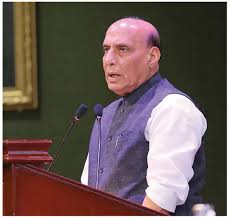
New Delhi: Defence minister Rajnath Singh on Wednesday voiced Prime Minister Narendra Modi-led government’s full commitment to the holistic development of border villages.
“Border villages are the country’s first villages and not remote areas, ” the Defence Minister said while speaking at the Border Area Development Conclave in New Delhi.
He pointed out that India’s geo-strategic position is such that it is exposed to different kinds of challenges and the best way to deal with them is to ensure border area development.
“Border Roads Organisation (BRO) has constructed over 8, 500 km of roads and more than 400 permanent bridges. Atal Tunnel, Sela Tunnel and Shikun-La Tunnel, which is going to be the world’s highest tunnel, will prove to be milestones in border area development, ” the Defence Minister said.
He added that the government has started the 220 Kilo-Volt Srinagar-Leh Electricity Line to connect the border areas of Ladakh with the National Electricity Grid.
He said that the transmission and distribution infrastructure of northeastern states is being strengthened. High-speed internet has been provided to over 1, 500 villages through the Bharat-Net broadband project.
“In the last four years alone, more than 7, 000 border villages have been connected with internet connection, and our focus has been Ladakh and Arunachal Pradesh, ” the Defence Minister said.
He said that the ongoing efforts have not only ensured prompt military deployments in sensitive regions but have also connected the people residing in border areas with the rest of the country.
He underlined the fact that while building roads, bridges and tunnels in border areas is imperative for national security, it is also important in making the lives of the people in these regions better, in collaboration with the state governments.
“Tourism has immense potential in border areas, but it could not reach the desired heights due to lack of infrastructure. Things have changed since this Government came to power. We are working towards development in these areas. From 2020 to 2023, the footfall of tourists in Ladakh, Sikkim and Arunachal Pradesh increased by 30%. Similarly, there has been a significant increase in Kashmir as compared to the last few years. This has resulted in job creation and strengthening of the local economy. We are taking consistent steps to make J&K a tourist hotspot, ” he said.
He also shed light on ‘reverse migration’, which he termed as one of the positive outcomes of economic development in border areas. He made special mention of Huri village in Arunachal Pradesh, a unique example of development through civil-military collaboration. He stated that while the central and state governments focused on economic progress, BRO and the Indian Army laid emphasis on infrastructure development, which resulted in reverse migration.













